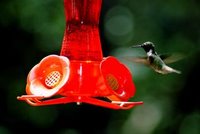Splendor in the Weeds – A Blue Grosbeak
Saturday, April 28th, 2007At 6:30 this evening, the sun was still well above the horizon and the day warm when I went for a late walk. It was windy, and the traffic noise from Highway 441 was especially loud. I had not taken binoculars with me, and was concentrating more on thinking than on watching or listening for birds. But a dark gray bird caught my eye when he flew from one bush to another in the weedy Old Field that lies between the road where I walk and the highway.
He sat low on a branch of privet, switching his tail, mostly in shadow, so that what I could see of him was little more than a silhouette. But his beak glinted silver, and his head looked large and slightly peaked. With all these hints, I still didn’t recognize him for a moment, and it wasn’t until he flew, crossing the sunny road to a small tree on the other side, and showing his large silver bill even more clearly, as well as a hint of blue in his plumage, and bronze in the wings that I realized what it was – a male Blue Grosbeak. Welcome back!
Blue Grosbeaks are among my favorite birds around our neighborhood. Despite the heavy traffic on the nearby highway, at least one or two pairs have nested in the Old Field just outside the entrance to our subdivision each year since we’ve been here. Against the background roar and rush of trucks, cars and SUVs, and the tangle of weedy shrubs, trees, grasses, honeysuckle, blackberry and kudzu vines, the Grosbeaks grace the scene with splashes of bright color, interesting behavior, and beautiful songs. Why they choose to live here, I can’t imagine, but I’m glad they do. Dark blue with orange wing bars and large silver beaks, the males sit in the tops of Chinaberry trees or small oaks and sing enthusiastically, especially early in the mornings. Depending on the light, they may appear more gray than blue, like the one I saw this evening, but when the sunlight strikes them clearly, their colors are intense.
